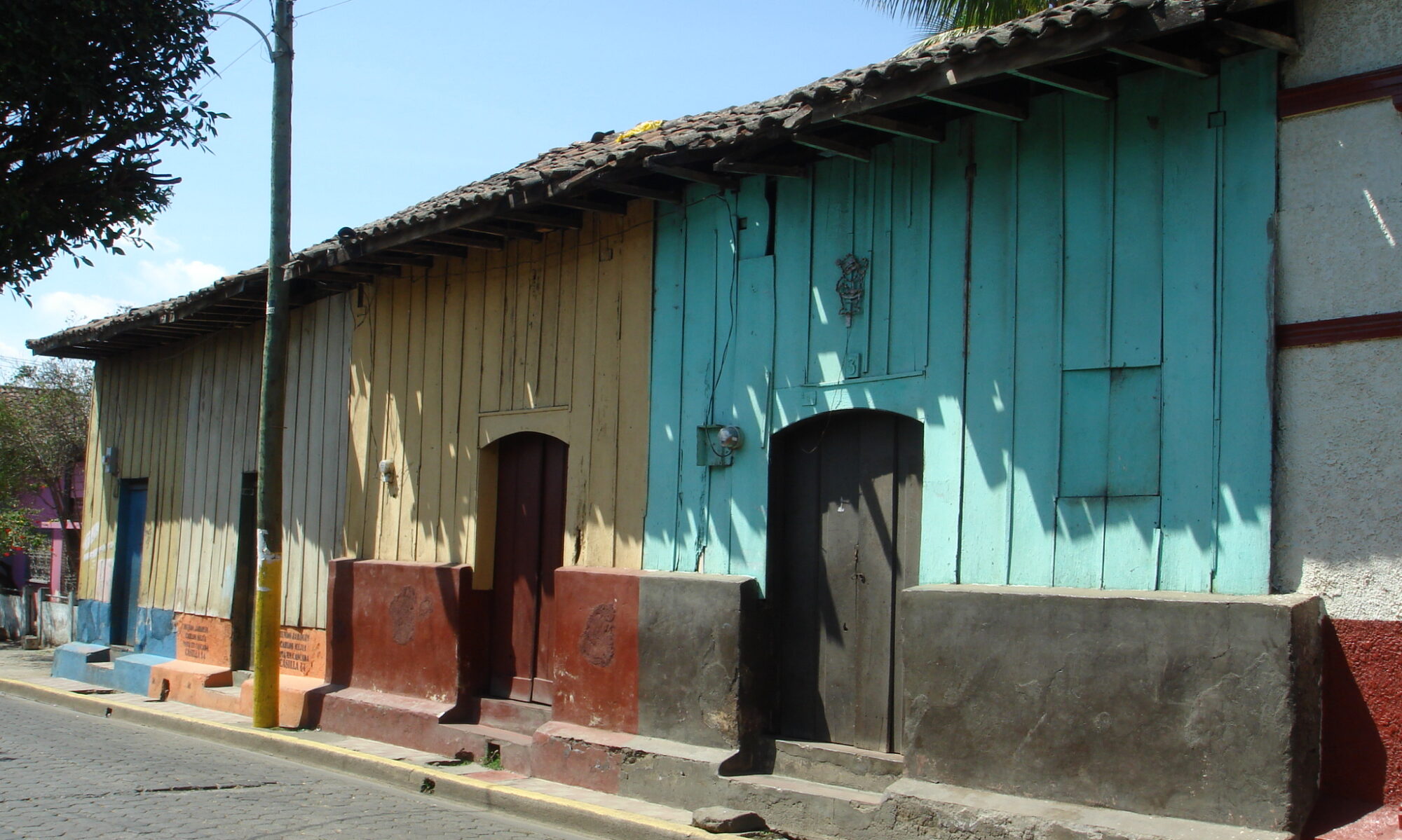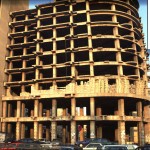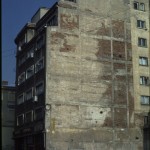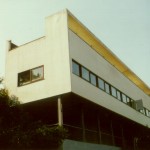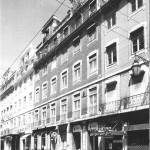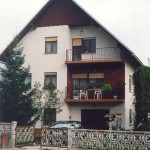by Maria D. Bostenaru
Such buildings generally range from 10 to 17 storeys in height with the ground floor being used for commercial purposes, whilst the upper floors house residential units. The vertical load bearing structure consists of moment-resisting reinforced-concrete frames which also generally serve as the lateral load-resisting system. However, when larger spans are encountered, reinforced-concrete structural walls are included to provide a dual structural system. Masonry infills built from lightweight concrete masonry units provide architectural space delineation. The seismic performance of such buildings constructed prior to 1977 varies from no damage to complete collapse. To date damage has usually been attributable to conceptual and construction mistakes.
Report # 96 : Early RC frame condominium building with masonry infill walls designed for gravity loads only
by Maria D. Bostenaru
This urban housing construction was practiced in Romania from 1907-1945, but predominantly in the 1930s, in the capital city of Bucharest. These buildings are mid- or high-rise (5-10 upper floors), often with two basements. Although there are several functional variations according to the usage and combination of flats, offices, and shops, this report discusses exclusive housing use. The number of housing units is variable. While smaller mid-rise buildings may contain one large luxury unit on each floor, taller buildings may include as many as eight small one-room flats, sometimes without a kitchen. The shape of the plan, containing L, U, H, or forms that cannot be described geometrically, and the elevation of the building are highly irregular. Upper floors may have recesses in the facade and may have corner towers. The load-bearing structure is RC skeleton designed for gravitational loads only. Columns are unevenly distributed so that beams at least one end are supported as secondary beams. Some beams are supported by columns with inadequate reinforcement or reduced sections of the RC members impede the formation of moment-resisting frames. The facade walls have solid clay brick masonry infill and improve the seismic behavior. The beneficial effect of masonry infill is influenced by the wall thickness, the size/position of openings in walls and the position of the partition wall to the frame. Staircases and elevators weaken the structure by introducing concentrated holes in flexible, thin RC slabs. Bucharest is located on alluvial soil deposits on river banks. Sandy ground or high levels of underground water have often presented problems for the foundation of buildings. Damaging earthquakes (M>7.0), centered in Vrancea, recur three times every century. These buildings were affected by the 1940 and 1977 earthquakes, but performed well relative to their high vulnerability. Out of the 61 buildings heavily damaged in the 1977 earthquake, 28 were of this type but were high-rise (7-9 floors).
Report # 95 : Prefabricated metal construction of the Modern Movement
by Maria D. Bostenaru
This urban housing construction was practiced for about 20 years during the early 1900s in Germany. Single-family houses and blocks of flats, both built according to the same construction system, are included in this report. This construction was built in what were once the outlying areas of German cities. Typically, these low-cost housing units are rented by the residents. The buildings consist of a row of several individual, 20-meter-long units, each of which usually contains two apartments on each floor. The load-bearing system is iron skeleton with brick infill. Usually, the skeleton is made out of columns and beams, but dense column grids were sometimes used to minimize the spans of metal joists as a cost-saving measure. Experiments with various materials for the bricks were tried as part of the continuous search for improved insulation. The floors are also made out of bricks on iron joists. Stiffening is usually provided by diagonal ties at the staircases, which are placed in the middle of each building unit. Because of the seismic activity, both along the Rhine and in the Swabian Jura affecting Baden-Wuerttemberg, seismic codes (DIN) were issued in 1981 and have been updated. Standards have existed since 1957 and are expected to be included in the new European code, Eurocode 8.
Report # 92 : Historic, braced frame timber buildings with masonry infill (‘Pombalino’ buildings)
by Rafaela Cardoso, Mario Lopes, Rita Bento, Dina D’Ayala
Pombalino buildings (see Figures 1, 2, 3 and 4) are historic masonry buildings that can be identified by the presence of a three-dimensional timber structure (named “gaiola pombalina”), which is enclosed in internal masonry walls above the first floor. The roofs are built with timber trusses clad with ceramic tiles and the floors are made of timber boards laid on timber joists. Ground floor walls are roughly dressed stone masonry supporting a system of vaults made of clay tiles, with stone arches. Foundations are made of short and small-diameter timber piles connected by a timber grid. These buildings were built after the 1755 earthquake when fear of new earthquakes led to the enforcement of anti-seismic provisions, such as establishing a maximum number of stories and introducing an interior timber structure called “gaiola.” The buildings originally were mixed-use with commercial enterprises on the ground floor and residences on the upper floors. During the 20th century, most Pombalino buildings underwent substantial refurbishment when they were converted and occupied entirely by banks and companies. For the buildings that have maintained their original uses, the main problems result from poor maintenance.The expected collapse mechanisms due to earthquake actions are the overturning of facades (out-of-plane) or shear failure at the plane of the walls at ground floor level (global shear mechanism), leading to a global collapse mechanism. Typical seismic strengthening of these buildings includes the introduction of a concrete/steel ring beam at the level of the roof eaves. The introduction of steel elements/pre-stressed cables or of anchors connecting parallel masonry walls is also common. Steel elements are also used to connect detached timber elements from the floors and gaiola to the masonry. New techniques applying new materials like Fibre Reinforced Polymers (FRP) are also used to increase the strength of the connections of timber elements that compose the gaiola.
Report # 91 : Single-storey brick masonry house (EMSB1)
by Mehedi Ansary
This is a one-story brick masonry house of fired bricks with cement or lime mortar; roof is either GI sheet or another material. These houses can be seen throughout Bangladesh. During the 1918 Srimangal, 1930 Dhubri, and other recent earthquakes, this type of housing suffered heavy damage. Houses with a continuous lintel suffered less.
Report # 88 : Confined brick masonry house
by Marjana Lutman, Miha Tomazevic
This is a very common single-family residential construction practice found throughout Slovenia, both in urban and rural areas. It is estimated that this construction accounts for approximately 40% of the entire housing stock in the country. Confined masonry has been practiced since the wide use of perforated clay blocks has started in the 1970s. The walls are constructed using perforated clay blocks in lime/cement or cement mortar. The main confining elements include horizontal reinforced concrete bond beams constructed atop the structural walls at each floor level, and vertical reinforced concrete tie-columns at the wall intersections. Floors are either of composite construction, consisting of concrete joists and hollow masonry tiles, or cast in-situ reinforced concrete slabs. Timber roofs are typically used in this type of construction. Since the first national seismic code was issued in 1964, the use of vertical reinforced concrete tie-columns is typically prescribed by the structural design. However, many existing houses were constructed without these critical structural elements. An additional deficiency characteristic for this construction practice is the absence of the top bond-beams along the gable walls (crown beams). This construction is expected to show good seismic performance. Buildings of this type were generally not affected by the past earthquakes in Slovenia.
Report # 87 : Block of flats with 11 floors out of cast-in-situ concrete, gliding frameworks
by Maria D. Bostenaru
This is an urban high-rise, built in Romanian cities, especially in Bucharest, during the Communist era. Romania is known as a seismically prone area. The epicenter of damaging earthquakes is near Vrancea and can affect half of the country at one time. Earthquakes higher than magnitude 7.0 on the Richter scale occur once in 30 years. Bucharest, the capital, is located on the banks of the Dâmbovita and Colentina rivers, on non-homogeneous alluvial soil deposits, around 150 km south of the epicenter in the main direction of the seismic wave propagation. This construction type is another example of a building with reinforced concrete shear walls. Unlike the OD type, described in report #78, this construction has more than just a single load-bearing wall in the longitudinal direction, and thus the behavior of the building under seismic loads is significantly improved. These exclusively residential buildings are found in large green-belt areas, in peripheral neighborhoods, either as an isolated building or in groups. Having uniform height and rectangular form, they generally contain four units on a floor. Characteristically, there is a ground floor with either 4 or 10 upper floors. This example is the Y-type, with 10 upper floors. The structural type is the “Fagure” (honeycomb) one, commonly used in Romanian construction practice. Although the perimeter walls are load-bearing, there are wide openings in them. During the earthquake of 4 March 1977 (Richter magnitude 7.2), over 30 buildings collapsed in Bucharest and killed 1,424 people. This type of building behaved rather well, with only superficial damage observed. Seismic strengthening was thus limited to repairs, where necessary.
Report # 86 : Single-family wooden house
by Norio Maki, Satoshi Tanaka
Japan has a long tradition related to wood construction. The main building of the Horyuji-temple, which was constructed in the late 7th century, is the oldest existing wooden structure in the world. Most Japanese housing is of wood construction. In 1993, 68.1% of the 45.8 million units of housing stock consisted of wooden structures. However, in newly constructed housing, the percentage of wooden structures is decreasing. In 1995, the percentage of wooden structures in newly constructed housing was 45.5%. The Hanshin Awaji earthquake disaster in 1995 damaged many wooden structures, especially housing that was constructed according to the pre-1980 building code. Despite the severe damage at the time of the Hanshin earthquake and governmental encouragement of seismic upgrading, retrofitting of these houses is not common.
Report # 85 : One family one storey house, also called “wagon house”
by Maria D. Bostenaru, Ilie Sandu
This is one of the oldest housing types in Romania with a statistically significant number of buildings in existence. The overwhelming majority of residential buildings in Romania have been built after 1850. Today. only churches remain from the previous “post-Byzantine” period. Issues relating to the age of historical buildings of cultural value are also discussed within the report. This urban housing type is particularly common in Romanian towns, especially in the southern part of the country, such as in the former Wallachia. It is a middle-class family house constructed from the end of the 19th century until the Second World War. The houses were designed to be semidetached, but have been constructed individually. Thus, in most of cases, the adjacent building, separated structurally, is a totally different construction type, The design of this housing is astonishingly homogeneous, especially considering the relatively lengthy time span the construction has been practiced. The single-unit housing is generally characterized by a rectangular, elongated-shape plan, with an entrance on the long side. The load-bearing system consists of two longitudinal unconfined brick masonry walls and several transversal unconfined brick walls, usually 28 cm thick, which form a wagon-like arrangement — hence the name of this building type. The horizontal structural system is made out of wood plates and joists separated by a distance of 0.70 m. Buildings of this type have been affected by damaging earthquakes in November 1940 and in March 1977, and by two earthquakes of lower magnitudes in 1986 and 1990. They performed well except for the occurrence of some minor cracking in the plaster.
Report # 84 : A single-family, two-storey house with brick walls and timber floors
by Maria D. Bostenaru, Ilie Sandu
This type of urban housing was constructed in Romania in the 1930s as single-family housing for the middle class. Typical buildings described in this report are one- or two-story buildings with load-bearing masonry walls. These buildings called “vila” in Romania are characterized by a rectangular plan and are usually semidetached; they share a common wall with the adjacent building. A great variety of buildings exist of this structural type. The building type described in this report has load-bearing brick masonry walls constructed of mud mortar. The floor structure consists of timber planks and joists. These buildings are located in an area well-known to be earthquake-prone. The epicenter is located close to Vrancea and earthquakes exceeding magnitude 7.0 on the Richter scale recur every 30 to 35 years. The latest earthquake of this severity was the March 1977 Vrancea earthquake (M 7.2). However, the building type described in this report is located in the Bucharest area and although affected by the November 1940 Naruja (Vrancea) earthquake (M 7.4), it usually performed well during the 1940 and 1977 earthquakes. The most common type of damage was in the form of cracks and falling chimneys. Some of the older buildings of this type have been affected by other past earthquakes. Because this construction is common for many Romanian buildings of the “Brâncovenesc” architectural style, new retrofit techniques have been developed in recent years (in addition to the techniques used after the 1977 earthquake).
